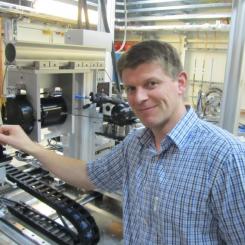 Dr Richard Martin
Dr Richard Martin
Aston University
Awarded: £118,917.50
The challenge
Osteosarcoma is the most common type of bone cancer, commonly affecting children and young people, but there are few treatments available. Additionally, some patients need bone grafts to replace bone that is diseased or damaged, but surgeons might have to take bone from other parts of the body, such as the hips, legs or ribs.
In previous work funded by Sarcoma UK, Dr Martin and his team found a material which could kill osteosarcoma cells. This project takes this one step further, developing a bone-replacement material which can not only kill cancer cells, but encourage healthy new bone cells to grow. It also contains an antibacterial which reduces the chance of the patient getting an infection after surgery.
How will this project tackle this challenge?
The material developed will be made of calcium and phosphorous, the key building blocks of bone. It will also contain gallium, a metal widely used in cancer treatment and known to target cancer cells while leaving healthy cells undamaged. Finally, it contains strontium, which can kill harmful microbes like bacteria.
The team will develop all these chemicals into one glass material, which will make delivering it easy for surgeons. The material will then provide a controlled release of important chemicals over an extended time period directly where surgery took place.
What this means for people affected by sarcoma
The team hope that developing new materials like this will help reduce the chances of infection after surgery and the possibility of the sarcoma coming back or spreading to other parts of the body. It will also help new bone to grow, reducing healing times. Ultimately the team hope this material will improve the outcomes and well-being for people with osteosarcoma.
This project will develop a bone-replacement material which can not only kill cancer cells, but encourage healthy new bone cells to grow. It also contains an antibacterial which reduces the chance of the patient getting an infection after surgery.












